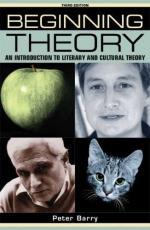
|
| Name: _________________________ | Period: ___________________ |
This quiz consists of 5 multiple choice and 5 short answer questions through Theory before theory - liberal humanism.
Multiple Choice Questions
1. What does Peter Barry say is the topic of the book Beginning Theory?
(a) Literary theory.
(b) Modern theory.
(c) English studies.
(d) Historical theory.
2. According to the narrator in the Introduction, the term "liberal humanism" became current in what decade?
(a) 1910s.
(b) 1930s.
(c) 1970s.
(d) 1920s.
3. What where the only two universities in England in the nineteenth century?
(a) Oxford and Cambridge.
(b) Birmingham and Buckingham.
(c) Manchester and Winchester.
(d) Kingston and Liverpool.
4. According to the narrator in the Introduction, the ________ probably saw the high-water mark of literary theory.
(a) 1980s.
(b) 1960s.
(c) 1990s.
(d) 1970s.
5. Which of F.R. Leavis's teachings was essentially a syllabus, manageable within a year-long undergraduate course?
(a) Great Expectations.
(b) Great American Literature.
(c) Great Explorations.
(d) Great Tradition.
Short Answer Questions
1. Who does the narrator say was the founder of a method of studying English which is still the norm today?
2. Who presented I.A. Richard with the manuscript of the book which was published in 1930 with the title Seven Types of Ambiguity?
3. The narrator explains in the Introduction that the emphasis on practice means that this is what form of book?
4. Who said the following quote found in the chapter titled Theory Before Theory--Liberal Humanism: "We are told that the study of literature 'cultivates the taste, educates the sympathies and enlarges the mind'"?
5. The narrator explains that the first prestigious name in English writing about literature was that of ________, who wrote his "Apology for Poetry" in about 1580.
|
This section contains 268 words (approx. 1 page at 300 words per page) |

|




